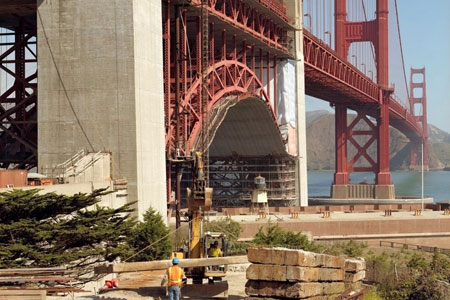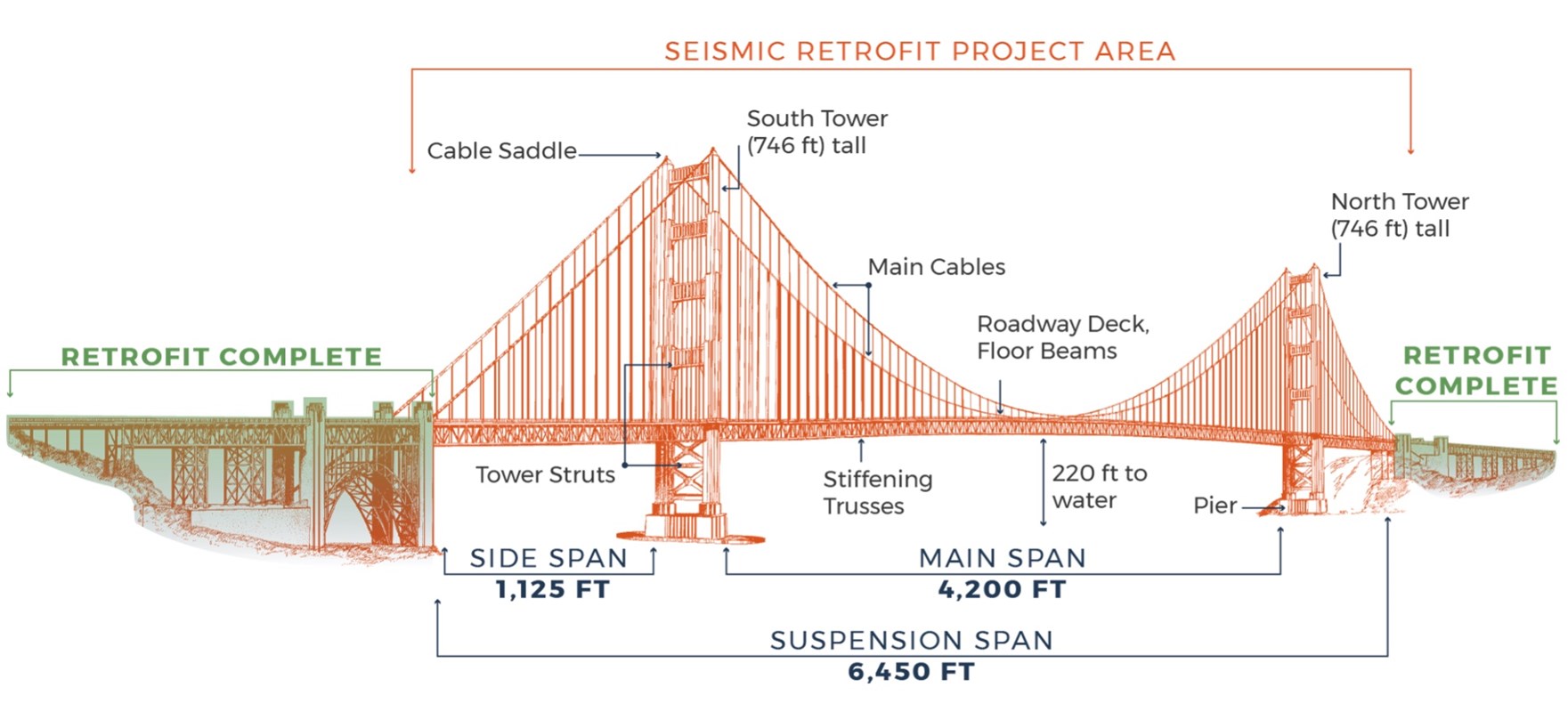
Seismic Retrofit Construction Project

The Golden Gate Bridge spans the Golden Gate Strait linking the City of San Francisco and the counties to the north. Serving up to 40 million vehicles a year, it serves a vital transportation link for the San Francisco Bay Area. The Bridge is operated by a special district of the State of California formed in 1928. This special district, the Golden Gate Bridge, Highway and Transportation District (GGBHTD), expanded its mission to include the operation of Golden Gate Transit bus system in 1971/1972 and the Golden Gate Ferry system in 1970. Spanning 1.7 miles from abutment to abutment, the Golden Gate Bridge is made up of six structures:
- San Francisco (south) Approach Viaduct
- San Francisco (south) Anchorage Housing and Pylons S1 and S2
- Fort Point Arch
- Main Suspension Bridge
- Marin (north) Approach Viaduct
- Marin (north) Anchorage Housing and Pylons N1 and N2
Loma Prieta Earthquake, October 17, 1989
It was a bone rattling, concrete crushing, nerve-racking 15 seconds. At 5:04 p.m. on Tuesday evening, October 17, 1989, the 7.1 magnitude Loma Prieta earthquake caused 68 deaths, at least 3,700 injuries and an estimated dollar loss of $6 billion to $7 billion. The earthquake reminded the world that the San Francisco Bay region remains vulnerable. Although the Golden Gate Bridge suffered no observed damage from the Loma Prieta quake, since the epicenter was located some 60 miles to the south, the earthquake became a catalyst for the extensive seismic retrofit program that the historic structure is undergoing today.
Perhaps the most impressive statistic resulting from research conducted since the Loma Prieta earthquake is the conclusion by the U.S. Geological Survey (USGS) and other scientific organizations that there is a 62% probability of at least one magnitude 6.7 or greater quake capable of causing widespread damage, impacting the San Francisco Bay region before 2031. Read the USGS 2003 fact sheet here: https://pubs.usgs.gov/fs/2003/fs017-03/fs017-03.pdf.
Immediately following the Loma Prieta quake, the GGBHTD engaged a team of consultants to conduct a vulnerability study. The conclusion of the study was that under a Richter magnitude 7.0 or greater earthquake with an epicenter near the Bridge, it would experience severe damage that could close this important transportation link for an extended period. If a Richter magnitude 8.0 or greater earthquake centered near the Bridge, there would be a substantial risk of impending collapse of the San Francisco and Marin Approach Viaducts and the Fort Point Arch, and extensive damage to the remaining Bridge structures, including the Main Suspension Bridge. It must be noted, that as of July 2008 with the completion of the second phase of construction, the seismic retrofit of the Golden Gate Bridge is far enough along that the Bridge no longer faces the potential for collapse and until the entire retrofit is completed, the risk of significant damage to the Main Suspension Bridge remains.
After determining that retrofitting the Bridge would be more cost-effective than replacing it, in 1992, the District hired engineering consultants to develop seismic retrofit design criteria. As part of this task, the site-specific design ground motions associated with different magnitudes of earthquakes and expected performance levels were defined as the basis for the Bridge retrofit design. The site-specific, moderate earthquake was defined as one having a 10 percent chance of being exceeded in a 50-year period or having an acceleration of 0.46g. The site-specific, maximum credible earthquake was defined as one having a return period of 1,000 years or having an acceleration of 0.65g, which is equivalent to the 1906 San Francisco earthquake of a magnitude 8.3 on the Richter scale.
Because of financial constraints, the District proceeded with phasing the construction of the seismic retrofit in a manner that reflected the degrees of structural vulnerabilities. In 1996, the three construction phases were established as follows:
- Phase 1: Retrofit the Marin (north) Approach Viaduct
- Phase 2: Retrofit the San Francisco (south) Approach Viaduct, San Francisco (south) Anchorage Housing, Fort Point Arch, and Pylons S1 and S2
- Phase 3A and 3B: Retrofit the Main Suspension Bridge and Marin (north) Anchorage Housing

Schematic of Retrofit Measures for Golden Gate Bridge